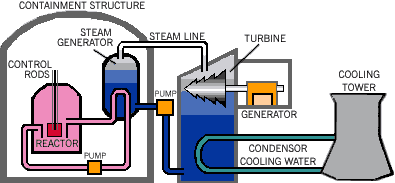The key to generating a steady output of energy is controlling the nuclear fission inside a reactor core. Too few fission events can slow down and ultimately stop the chain reaction. Too much fission can overheat the core and lead to a meltdown.
Nuclear engineers and technicians precisely control the amount of fission taking place by inserting control rods (upper left) into the fuel assembly (red box). The rods are made of a substance that readily absorbs neutrons, like graphite or cadmium. When things get too hot, technicians lower a few control rods into the core. The rods sop up some of the ricocheting neutrons, and the fission process slows down. The reverse is also true: control rods are removed to rev up the fissioning. This simplified graphic illustrates this principle.

When control rods are lifted from the fuel assembly, neutrons (from the natural decay of uranium) bounce around and bombard other uranium atoms, causing them to split. This process gives off more neutrons and causes more splitting. This is a chain reaction. The heat generated from all this fissioning is converted into steam, which turns a turbine, which turns a generator that produces electricity.
If the reaction gets too hot, the control rods are re-inserted to absorb neutrons. With fewer neutrons around, there is less bombardment and fissioning. The core cools; energy output slows down.